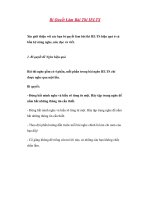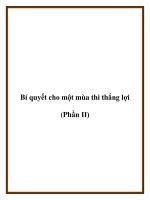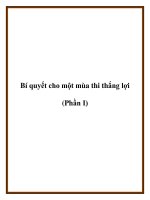IELTS listening tips (bí quyết cho phần thi nghe IELTS)
Bạn đang xem bản rút gọn của tài liệu. Xem và tải ngay bản đầy đủ của tài liệu tại đây (66.1 KB, 1 trang )
IELTS Tips - Listening
•
•
•
•
•
•
•
•
The accents of the speakers on the tape are primarily British. This means you must become
accustomed to understanding the nuances of such accents. If you have been watching a lot of American
television, (shows such as Friends, for example) it will not really help you. British accents are quite
different and it is better to spend time in the months before the test listening to British radio stations and
podcasts or watching the BBC, British shows, and movies. This is one of the major difference between
the IELTS exam and the TOEFL, which features more American accents.
Get used to the way letters and numbers are pronounced in British (and American)English.
Sometimes, in the listening section, you are asked to write down the spelling of a name, place, or address.
If you make a mistake in the spelling while writing it down, you will get the answer wrong.
The expressions used also tend to be taken from British rather than American English. This
means you may hear unfamiliar idioms, which can confuse you. Speakers may also use British words for
common items such as "flat" for "apartment", "lorry" for "truck", or "advert" for advertisement. Make
sure you study the most common differences in British and American vocabulary and listen to as many
IELTS exercises as possible before your exam to prepare you for the actual test experience.
Learn to distinguish opinion from fact. In the third and fourth listening passages, you will
probably be tested on what one of the speakers thinks or what his / her view is. This may or may not be
stated outright, but as an underlying theme in the whole conversation or in the tone of the speakers voice,
rather than the words themselves.
Don't worry if your classmates or friends get higher listening scores than you. Each one has his
or her strengths and weaknesses, just like you. Each one also has his or her own language goals. Just
focus on your own needs and don't compare yourself to others.
Follow instructions very carefully. If the instructions state, "Write no more than three words",then
you must not write more or you will receive no marks for your answer, even if some of the words you
wrote were part of the correct answer. Similarly, read each instruction carefully. Sometimes, you are
asked to circle two answers, sometimes three, and so on. You must read the instruction each time as it
may differ from the previous ones. Remember, the ability to follow instructions in English is a test in
itself.
The questions follow the oral text. Remember this - it will make it easier for you to focus on the
current question, or to know when you've been left behind, in case the speakers have gone on to
providing the answer to the following questions.
Familiarize yourself with charts, graphs, flow-charts, bar charts and pie charts, etc. These
often appear as part of the answer choices in the fourth section. The more comfortable you are with
interpreting the data represented in them, the easier your exam will be.
![7 bi quyet cho nguoi hoc tieng anh[easyvn net]](https://media.store123doc.com/images/document/13/gu/md/medium_mdd1375920077.jpg)








